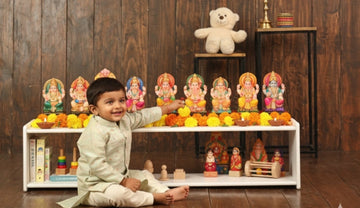Navratri is one of India’s most vibrant festivals, celebrated across nine nights with dance, music, devotion, and color. It is a time for family, tradition, and reflection. For children, Navratri can be a rich opportunity to learn while participating in meaningful cultural experiences. By including them in small, hands-on activities, you help nurture independence, creativity, confidence, and a sense of belonging.
Here are six Montessori-inspired ways to involve your child in Navratri celebrations. Each activity is simple, safe, and designed to make the festival enjoyable while supporting their development.
1. Decorating the Golu or Puja Space

Invite your child to help arrange dolls, idols, or flowers in the puja or golu setup. Encourage them to sort items by size, color, or type before placing them carefully in the display. These simple steps build focus, organization, and patience while giving them a sense of contribution.
You can also assign small tasks like dusting the area, arranging mats, or helping place diyas with supervision. Completing these activities successfully instills pride and confidence. It shows children that their efforts make a real difference in family celebrations.
2. Festival Storytelling

Share stories about Goddess Durga, her nine forms, or the triumph of good over evil in simple, age-appropriate language. Use picture books, puppets, or illustrated cards to make the stories engaging. Afterward, encourage your child to retell the story in their own words or use gestures to act it out.
This activity nurtures imagination, develops language skills, and improves memory. It also helps children connect emotionally to the values of courage, kindness, and determination that Navratri celebrates. Repeating stories encourages comprehension and makes learning enjoyable.
3. Traditional Dress Choices

Allow your child to take part in choosing their festive attire, such as chaniya cholis, dhotis, or kurtas. Offer them small options like which dupatta to wear or which bindi to pick. This encourages decision-making and independence while giving them ownership over their choices.
You can explain the significance of colors and fabrics or talk about cultural traditions linked to the clothing. Dressing up becomes both educational and fun, fostering pride and excitement in participating in the celebration. Children learn about self-expression and personal responsibility in a safe, guided way.
4. Dance and Music Participation

Garba, Dandiya, and devotional songs are central to Navratri. Encourage your child to join in, even if it is clapping to the rhythm, tapping their feet, or moving to the beat. Dancing develops gross motor skills, balance, and coordination while providing a joyful way to express energy.
Music and rhythm also enhance listening skills and memory, while group participation fosters teamwork and social interaction. Celebrating through movement helps children connect with tradition, improves their physical confidence, and turns festive moments into memorable learning experiences.
5. Festival Arts and Crafts

Set up a small creative corner where your child can participate in rangoli making, coloring pictures of deities, or making paper decorations. Working with colors, textures, and shapes helps improve fine motor skills and attention span.
Encourage them to display their work in the puja area or near the home entrance. This gives children a sense of accomplishment and demonstrates that their contribution matters. Arts and crafts during festivals reinforce creativity, patience, and pride in doing meaningful work.
6. Involving Them in Festive Meals

Navratri meals are full of tradition and variety. Invite your child into the kitchen with safe, simple tasks such as washing vegetables, stirring batters, or arranging fruit on a plate. Supervised participation builds confidence and helps children feel included in family rituals.
When children see the result of their effort on the dining table, it strengthens their sense of contribution and accomplishment. Cooking also provides valuable sensory experiences, teaches basic coordination, and introduces them to cultural traditions through hands-on learning.
Making Navratri Joyful and Educational
Navratri is not just a festival of rituals. It is a celebration of family, culture, and growth. By giving children small, meaningful roles in the festivities, you help them develop independence, responsibility, and curiosity. Each activity, from arranging the golu to joining in Garba or helping in the kitchen, becomes an opportunity for skill-building and joyful learning.
These shared experiences allow children to connect with tradition, understand cultural values, and create memories that will stay with them for a lifetime. Celebrating Navratri in this Montessori-inspired way encourages participation, self-expression, and confidence, turning a festival into a powerful learning experience.






